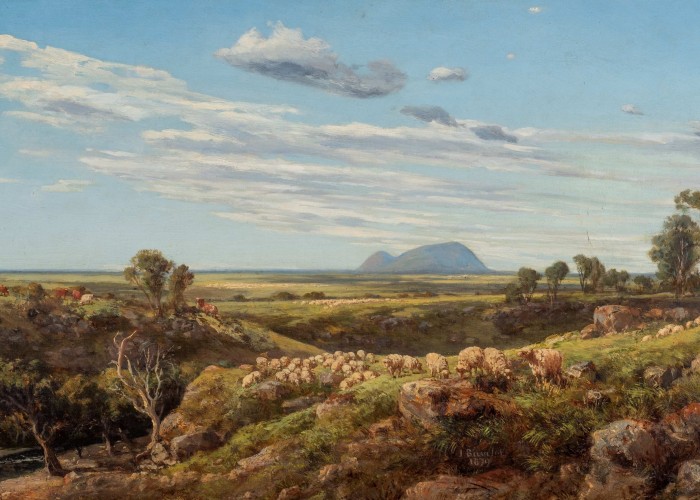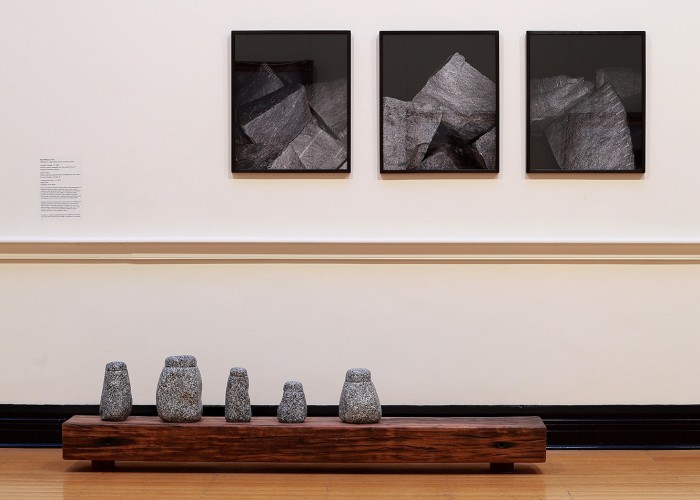Stonework
7 September 2023—28 February 2025
Stonework
– Uncle Rick Nelson, Community Elder, (Jaara) Dja Dja Wurrung
There are many ways of looking at a stone. For First Nations artists with a deep knowledge of their Country, stones and rock formations have a spiritual and cultural energy as well as intrinsic and material qualities of colour, sharpness, hardness, weight.
A different attitude to stones developed in Europe in the 19th century. Sharp-eyed natural historians turned their attention to mountains and valleys and developed a controversial new discipline – Geology. These quarrelsome thinkers challenged the traditional view, based on the Biblical studies, that the Earth was only 6,000 years old. Many artists had a working knowledge of these dangerous new ideas. And with the discovery of gold in the Castlemaine region in the early 1850s, an obsession with faults and seams, uplift and anticline was almost universal in Central Victoria.
With rocks in mind, works by Louis Buvelot, Arthur Streeton, Frederick McCubbin, W. B. McInnes, Elma Roach and Penleigh Boyd show landscapes that are dynamic and alive, constantly weathering, warping, folding, eroding, erupting or sinking.
Contemporary artists, sculptors, photographers and jewellers also reveal unexpected aspects of rock and stone: geometry, ritual, even relationships to memory and trauma. Contemporary artists include Stephen Bram, Alvin Darcy Briggs, Pete Curly, Brodie Ellis, Sally Marsland and Felix Wilson.
The exhibition also includes historical maps: the work of geologists and cartographers from the Geological Survey of Victoria, who in the 19th century meticulously surveyed and mapped both the visible and the subterranean flows of rock and sediment. While in the 20th century, local amateur enthusiasts returning home with pockets full of stones, have created the rock collections which fill the museum cases. Specimens of minerals and fossils ground the exhibition in the physical world and introduce the viewer to the concept of deep time.
One of the most intriguing works exhibited is the Hoddle-Selwyn map on loan from the Geological Survey of Victoria. Visually engaging and remarkable for its historical significance the map is nevertheless hard to read on the gallery wall. For this reflection, Clive Willman has created a video illuminating its importance to the settlement of the goldfields as well as evidence of First Nations management of country.
https://www.youtube.com/watch?v=E7xcuh2W63E
Exhibition Curators
Jenny Long and Clive Willman
Castlemaine Art Museum would like to thank Curators Jenny Long and Clive Willman, Uncle Rick Nelson, the artists and lenders, the Geological Survey of Victoria, Dr Bill Birch, Felix Wilson, Deborah Peart, Union Studios.
Education Resource for Schools and Young People
Two free Education Resources have been designed to assist both teachers and self-guided visits with young people to embed this exhibition within their classroom curriculum or their own exploration.
Primary Education Resource
Suitable for ages 4-12.
The resource can be used to address all Visual Arts Curriculum components from years F–6.
Click here to access/download the Stonework Primary Education Resource
Secondary Education Resource
Suitable for ages from 12, and the young at heart.
The resource can be used to address all Visual Arts Curriculum components from years 7–10.
Click here to access/download the Stonework Secondary Education Resource
These free resources provide substantial information and practical activities to enrich this exhibition for young people and allow them to creatively respond to the works. They are designed to be flexible and can be adapted for teachers in the classroom, an exhibition visit at CAM, or for visitors and young people in the gallery.
Public Programs
Free public programs, including artists in conversation and workshops, will be presented in the gallery throughout this exhibition. All details will be shared on our website. Click here to subscribe to our mailing list to receive updates and invitations.
Supporters
Friends of Castlemaine Art Museum (FOCAM)
Tom Burrowes
Education Supporter
Novo Resources

